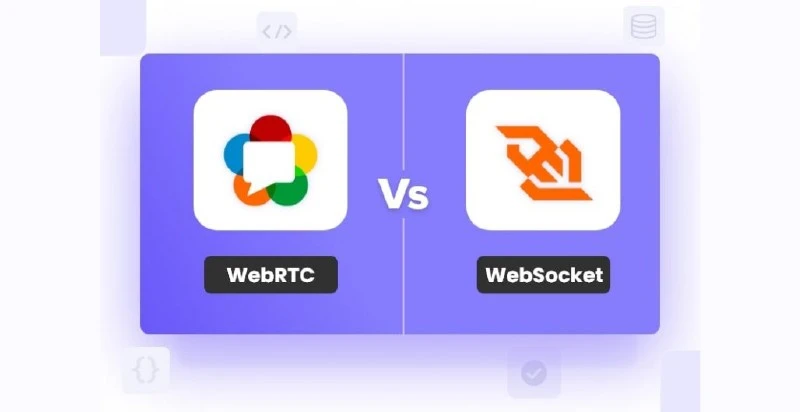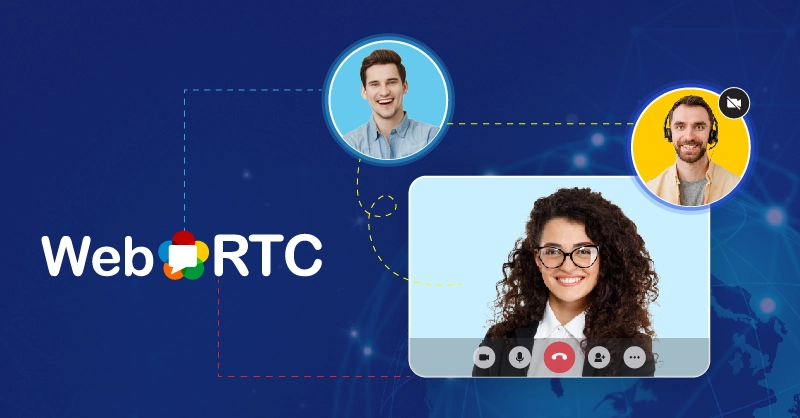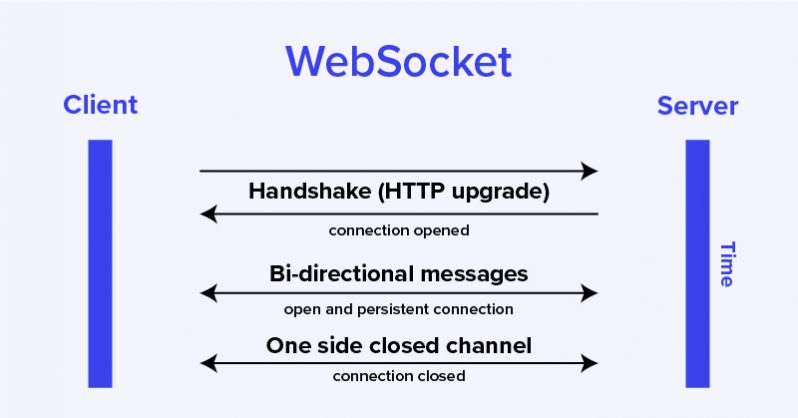WebRTC vs WebSockets – Which One is Right for Your Application?

With the pace with which communication is happening, everyone wishes to experience lag-free video or voice chats in their chat platform, but unfortunately, it takes a tough stone to make a tender video calling app.
Besides the time and cost involved to build a video chat app, many business owners are starting to feel gritty about whether to choose WebRTC vs WebSocket as the communication protocol as both are the front runners of communication.
Fortunately, research has helped man in identifying that WebRTC is slightly preferred over any other protocols.
So, in the article below, we’ll give a fair insight into the comparison of WebRTC vs WebSocket and other factors to help you make an educated decision for your app.
Table of Contents
What is WebRTC?
WebRTC (Web Real-Time Communications) is an open-source communication protocol created by Google that enables real-time chat, voice, and live video call between web applications and devices. They can also handle multiple device connections without losing their integrity with the help of signaling servers.
The WebRTC protocol is device and platform independent and so can be implemented as an open web standard on all mobile devices. Be it Android, iOS, or browsers like Microsoft Edge, Google Chrome, Mozilla Firefox, Safari, Opera, BlackBerry, and Internet Explorer, WebRTC technology supports any OS with simple JavaScript APIs.
What is WebSocket?
A WebSocket is a type of communication protocol that allows for a persistent, bi-directional, and full duplex TCP connection between user’s browser and server.
This server-to-client message delivery tool is used by developers to predominantly establish real-time voice and video communications. In most cases, WebSockets are used to display data continuously on the client side. A perfect example of it would be a bitcoin trading website, where the backend server displays trading data continuously on the dashboard.
How Does WebRTC Work?

When two users send and receive messages using the WebRTC protocol, there comes the next challenge. They will be connected to Private networks (ISPs) but their apps will need Public IP addresses to connect them.
It’s here, Network Access Travel (NAT) comes to help that translates the Private IP addresses into Public IP addresses without any breach of privacy and security.
NAT works with 2 servers – STUN (Session Traversal Utilities for NAT) and TURN (Traversal Using Relays around NAT) servers for this process. At this point, we’ll use WebRTCs to negotiate the connection between the computers via the servers mentioned above.
In real-time, when user 1 starts a video call,
- The browser of User 1 initiates the request to either STUN or TURN servers which in turn inform your device about your Public IP.
- Now, your device will let the second user know how to connect to your Public IP.
- User 2 connects to User 1 and this process is known as Signaling.
- From this point, both the users can make real-time conversations with each other more effectively.
Let us focus on other factors concerning WebRTCs.
- Development Environment: C++, Java, Java Message Service (JMS)
- Connection Stability: Uses one server
How Do WebSockets Work?
Let’s look into a practical scenario where two users need to make a video call using a web app.

When user 1 makes a video call to user 2, both their browsers must be able to send/ receive messages at the same time. These browsers are connected by a central web server, which brings us to an understanding that the constant communication between the browsers and server is what yields us real-time interaction.
In the backend, the following process occurs:
- User 1 starts a video call, his/ her browser initiates an HTTP request to the server.
Note: When the server sends a response to this request, the communication becomes two-way. Unfortunately, this server cannot initiate requests/ responses on its own. It requires a communication protocol to make the server send a response.
In such cases, WebSockets are used by web developers.
When a web app uses WebSockets, the same process changes as follows:
- The browser (client) sends a ‘handshake’ request to the server.
- The WebSockets help the server to give back a handshake response.
- At this point, the protocol switches from HTTP to Websockets, establishing successful communication across browsers.
- Thereby, both users can send/ receive data at the same time.
Let us focus on other factors concerning WebSockets.
- Development Environment: HTML editor & server, JavaScript editor & server
- Connection Stability: Ideal for directly connecting 2 or more users
Are you still in a dilemma on which protocol to choose?
When to Use WebRTC?
WebRTCs are a great choice by developers for developing the following use cases.
WebRTC
- HTML 5 Applications
- IoT Apps
- Live Broadcasting
- Customer Support
- HR Management
- AI-based Conversational Assistant
- Social Networking
- Healthcare
- Real-time Marketing & Advertising
- Virtual Medical Consultations
WebSocket
WebSockets are highly preferred for the following use cases.
- Video Conferencing
- Social Feeds
- Sports Updates
- Location-based Apps
- Online Education
When to Use WebSocket and WebRTC?
Both WebRTC and WebSockets are complementary technologies. One uses the other for developing different use cases. Though WebRTC is used to build P2P video chat apps, it makes use of a signaling server for opening and closing communication.
WebRTCs do not provide any signaling implementation on their own. Here, the WebSocket protocol is used as a signaling mechanism for all WebRTC applications.
WebRTC vs WebSockets: Key Differences
- WebRTC is used for all P2P communications among mobile and web apps using UDP connections but WebSockets is a client-server communication protocol that works only over TCP.
- WebSockets uses TCP connections, the chance of data integrity is higher when compared to WebRTC. However, speed is unmatched with WebRTC protocol.
- WebRTCs are mainly designed for audio and video streaming. Though these are possible with WebSockets too, they are best suited for transmitting data strings using JSON formats. To organize strings of JSON and make it easy to understand, you can use the JSON formatter.
Now that we saw the basic difference between the two protocols, let us detail our study on the
Let’s Explore the Pros and Cons: WebRTC vs WebSockets
Advantages and Disadvantages of WebRTC
Advantages and Disadvantages of WebSockets
Which Coding Language is Best for WebRTC and WebSockets?
WebRTC and Websocket can be used along with various kinds of programming languages based on personal preferences, project requirements, and existing infrastructure. Here are some famous programming languages for both:
| WebRTC | WebSocket |
|---|---|
| Java | Java |
| JavaScript | JavaScript |
| Node.JS | Node.JS |
| Python | Go |
| Ruby | C# (ASP.net or Code) |
Can WebRTCs Replace WebSockets?
A WebSocket establishes a connection between two browsers (clients) via a web server. When these browsers interact, WebRTCs help sends and receive messages between these browsers without involving the web server that’s mentioned above.
This delivers a clear message that WebSockets and WebRTCs are two separate entities in the same process. These technologies play unique roles in establishing real-time communication across web apps and browsers.
The Verdict
From our analysis above, it is clear that WebSockets and WebRTCs cannot be directly compared against each other. However, if we were to question the robustness of both these protocols, it is no doubt that WebRTCs take the winning side for the quality of video communication transfer across devices.
If you are interested in a similar comparison between XMPP and Websockets, we’ve written an article on it – Click Here to Read!!!
Drive 1+ billions of conversations on your apps with highly secure 250+ real-time Communication Features.
Contact Sales200+ Happy Clients
Topic-based Chat
Multi-tenancy Support

Frequently Asked Questions (FAQ)
WebRTC and Websockets are two different entities, and they serve different purposes in real-time communication and web development. They are never direct replacements for each other.
A web socket establishes a connection between two browsers (clients) via a web server. When these browsers interact, WebRTCs help send and receive messages between these browsers without involving the web server that’s mentioned above.
WebRTC is known to offer peer-to-peer (P2P) communication capabilities for mobile and browser apps using the UDP whereas WebSockets establishes a client-server connection with the aid of TCP protocol. And so, WebRTCs are known to be considerably faster than WebSockets. Plus, WebSockets are highly preferred when it comes to data integrity because of the underlying TCP reliability. But in the case of WebRTC, data reliability is a little less.
Yes, Considerably WebRTC is faster than Websocket, as WebRTC uses UDP (User Datagram Protocol) to facilitate ultra-low latencies in audio and video real-time communications. On the other hand, WebSocket uses TCP (Transmission Control Protocol), which is slightly slower compared to UDP.
WebSockets are much faster than the traditional Http due to the following reasons:
- Low latency
- Reduced overhead
- Persistent connection
- Efficient communication for real-time updates
- Smaller data transfer
Websocket has multiple alternatives; everyone comes with their own features, use cases, and trade-offs. Here are some listed below:
- MQTT
- WebRTC
- HTTP Long Polling
- ServerSent Events (SSE)
- gRPC
- Socket.IO
Yes, as of a recent announcement from WhatsApp. They officially confirmed that they make use of Websockets for real-time sync of messages while using WhatsApp web over web browsers like Chrome, Bing, etc.
Yes, Socket.IO is a better choice to use in video streaming. That too, specifically when you are in need of real-time bidirectional communication. Socket.IO is a Java script library that enables real-time, event-driven communication between clients and the server.
WebRTC is known to offer peer-to-peer (P2P) communication capabilities for mobile and browser apps using the UDP whereas WebSockets establishes a client-server connection with the aid of TCP protocol. And so, WebRTCs are known to be considerably faster than WebSockets. Plus, WebSockets are highly preferred when it comes to data integrity because of the underlying TCP reliability. But in the case of WebRTC, data reliability is a little less.
Webhooks and Websockets are both used for real-time communications between web apps, but they both have different characteristics in the below-mentioned methods.
- Communication model
- Initiation of communication
- Connection duration
- Protocol
- Use cases
- Error handling
Related Articles
- A Quick Guide On WebRTC Video Calling for Developers
- What is WebRTC Protocol and How Does it Work?
- WebRTC Encryption and Security [Detailed Guide]
- 20 Essential WebRTC FAQs [Tips & Examples]
I want to use your video API for my ecommerce app. I would like to discuss regrading number of users can join in a group video call, pricing etc. kindly get back to me
Hi, We are looking for a Video API for our video chat app to create a private voice and video calling feature. we are looking for more details on the pricing.
Thanks for sharing great article I notice that customizability is at the forefront of your chat solution. I would like to chat more about that to see if it right for my use case or not.
I think very very detailed article for those who try to build video chat app using WebRTC or Websockets technology. Thank You.
Amazing Article! Thanks for sharing this with me and keep up the good work and very detailed information about WebSocket vs WebRTC.
Fantastic article. As I would see it, extraordinary compared WebRTC and Websockets Messaging protocols, you make everything so easy to understand. Thank you so much. You speak to the very experienced and the professional.
Really great article, which has lots of good information, when someone is in search of Websockets vs WebRTC.
Hey Really happy to say, your post is very interesting to read about WebRTC vs Websockets. You’re doing a great job.
Very Informative blog! Thank You guys, the article is really helpful. It taught me the comparison of WebRTC vs Websockets. Thank You for sharing your insights.
Interesting Articles! Thanks for the sharing I am also looking the comparison of WebRTC vs Websockets. I will pin your post. Thanks
Hi Great article. As I would see it, extraordinary compared WebRTC and WebSockets, you make everything so easy to understand. Thank you so much.
Very useful information and it is well arranged about WebRTC vs Websocket, so was pretty easy for me to read it. Thanks for the article. Great work!
Hello I want to develop Video calling feaure between Doctor and Patient for both andoid and ios device. Can you please guide how can i integrate MirrorFly in it.
Good information about webrtc and websocket to build video chat app. The post is well designed and well written. Full of helpful information.
Great article about WebRTC and Websockets. Need Video API for my ios and android app. Could you please tell us your prices, and do you have any demo.